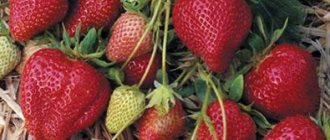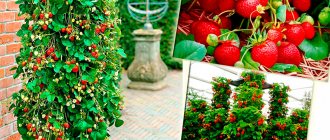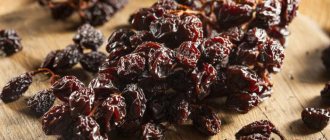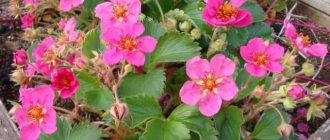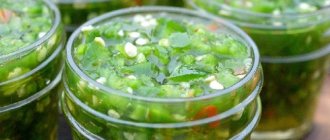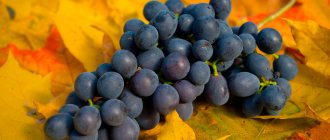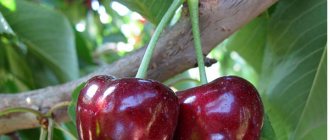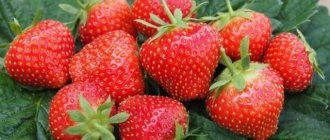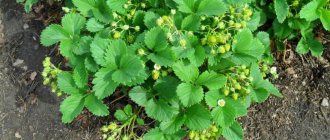Features and advantages of ampelous strawberry varieties
The word “ampel” itself translated means “hanging vase of flowers.” In order for a hanging strawberry to form, you need to plant several bushes in one flowerpot and wait until the mustaches and rosettes form. Most often, remontant varieties are chosen for such cultivation, which are capable of bearing fruit for a sufficiently long period of fruiting. Very often, this kind of strawberry is grown as a decoration. Plants that are decorated with flowers, rosettes and berries of varying degrees of ripeness all summer long look very advantageous.
Using ampelous strawberries in interior design
If you plant non-remontant varieties, then the flowering and fruiting period will be short and people will not have time to enjoy all the beauty of this type of planting.
In addition to the ampel method, you can make the resulting mustache weave. This requires a garter at certain stages of flowering.
Important! When planting and subsequent formation, it is important that the plant has the correct shape.
Variant of arrangement of pots with strawberries
Other boarding options
Ampelous remontant strawberries are grown not only indoors and on balconies, but also in open ground. For example, some people plant these plants on a trellis. Thus, you can decorate your plot in an original way, and also get a wonderful harvest of delicious berries.
Not only a lattice, but also any fence is suitable as a vertical surface. Strawberries are planted at a distance of about 30 cm. As the mustaches form, they must be tied to the surface, trying to completely cover the entire trellis. The height of the grate should be no more than 1 meter.
More inventive gardeners plant strawberries in the shape of a pyramid. Such a bed looks more like a beautiful flower bed, and can pleasantly surprise your family and friends. To do this, you need to build 3 boxes of different sizes. The first, largest box should have a bottom, but the 2 smaller boxes should not. The height of the containers may be the same or may differ. Now the boxes are gradually filled with soil and laid out in the shape of a pyramid, as shown in the photo. Strawberries are planted in them at a distance of about 20 cm.
Attention! The number and shape of the pyramid levels depends on your desire and imagination.
The best varieties of ampelous large-fruited strawberries for growing
Among the large-fruited strawberries recommended for growing using the hanging method, the following are distinguished:
Ampel strawberry Rikla
How to care for ampelous geraniums at home
The variety was developed for the North Caucasus region. It ripens early, but is not remontant. It is light green in color, has a spherical shape, and forms a moderate number of shoots. The fruits are characterized by scarlet color and conical shape. The flower stalks themselves are located at the level of the leaf blade. The berries weigh up to 36 grams. Each fruit contains 7% sugar. The variety has a high level of heat resistance and frost resistance.
Ampel strawberry Elsanta
Characterized by an average ripening period. They have an average amount of foliage. The large leaves have a slight fluff and a lush green sheen. Increased wrinkling. It is distinguished by thick, tall peduncles that are located close to the foliage.
Note! The fruits weigh up to 50 grams and are cone-shaped. They have a slight sourness.
Ampelous strawberry Tarpan
It is recommended to grow this variety outdoors or on balconies. It has bright pink flowers and elongated peduncles. The weight of the berries can reach 35 grams. They have a pronounced strawberry aroma and are very tasty.
Victoria ampelous
The variety is quite common and has received positive recommendations from many gardeners. The bush has a fairly large shape. Characterized by high frost resistance. However, sensitivity to spring frosts remains. The variety is very resistant. Loves abundant watering. Has a short shelf life. Predominantly high taste qualities.
Strawberry ampelous Temptation
It has some features that are ideal for growing in midland conditions. One of these characteristics is that fruiting is observed even on those mustaches that do not have a root system. Good for growing on balconies in flowerpots or pots. The weight of the berries is about 30 grams, they have a sweet taste with a nutmeg aroma. The pulp is juicy and dense. Yields about 1.5 kg per plant and is characterized by high yield;
Ampel strawberry Delis
New for 2021. Produces 1.5 kg of berries per plant. The bush is medium in size and has a very developed root system. The berries are round in shape and have a special aroma.
Ampel strawberry Laurent
It begins to bloom and bear fruit very early. It has an ideal shape for growing in pots. The foliage is dark green in color. The duration of fruiting is from mid-June until frost. The fruits have a conical shape and a dark red hue. Very juicy and sweet.
Important! Each variety has its own advantages and disadvantages. When choosing the ideal plant, you should be guided only by personal wishes.
Varieties of ampelous strawberries
How to care for ampelous strawberries?
To harvest a bountiful harvest several times a year, it is important to properly care for the plants. For this purpose, you need to know the following requirements:
It is important to observe the temperature regime, so for seedlings of ampelous strawberries before flowering, 10-15°C is enough. When the berries begin to ripen en masse, it is worth maintaining 22-25°C
In this case, the air humidity should be about 60%. For ampelous strawberries, lighting conditions are important. During the period of flowering and fruit formation, the duration of daylight should be at least 14 hours. In cold times, it is recommended to take care of artificial lighting and heating.
Caring for ampelous strawberries in winter
When growing plants outside, it is important to take care of covering the bushes for the winter, especially if the temperature drops to -20°C and there is little snow. This is important to prevent the roots from freezing
Covering is necessary during regular frosts, but if the temperature rises, it is better to clean the bushes to prevent damping off. Large-fruited ampelous strawberries can be covered with pine spruce branches, hay, straw, dry leaves and agrofibre.
Garden ampel strawberries - soil
It is important to use soil that is enriched with mineral fertilizers, nitroammophos, saltpeter and cow manure. You should focus on the following proportion: for 10 kg of soil, fertilizers are required in the proportion of 15:20:1000 g
Before planting ampel strawberries, the soil must be sifted so that it becomes “airy”. As a soil mixture, you can use peat and turf mixed in a 2:1 ratio with the addition of a small amount of sand. Another option is to use prepared soil for strawberries.
How to feed ampelous strawberries?
Since almost all varieties produce abundant fruiting, after it the bush is depleted, so it needs abundant and regular feeding. Growing ampel strawberries involves adding nitrogen and potassium to the soil. As for phosphorus, it only needs to be fed once - before planting. Feeding is carried out according to the following scheme:
In the third ten days of December, urea is added to the soil
It is important to use a 1% or 2% formulation. In the second half of June, it is necessary to water the bushes with liquid cow manure or chicken droppings. Together with organic fertilizers, it is recommended to use mineral additives, for example, “Solution” or “Crystallin”.
Ampel strawberries - watering
It is important for this crop to receive regular watering. It is necessary to ensure that the soil is moist, which will promote the rapid growth of young foliage
There are several rules for watering:
- To increase fruiting, after harvesting remontant strawberries, you should trim them and start watering the bushes with warm water.
- It is recommended to irrigate the soil at sunset or in the morning to protect the plant from sunburn. After this, the soil must be loosened and mulched.
- You cannot water the bush from above, so pour water under the root. If you neglect this rule and liquid gets into the center of the rosette, the plant may die.
- The frequency of watering is determined by the condition of the soil; if it slightly sticks to your hands, then everything is fine, but if it crumbles, then irrigation is carried out.
- During fruiting, strawberries should be watered once every five days. It is best to give preference to drip irrigation.
Ampelous strawberries with pink flowers: care and cultivation
Caring for ampelous geranium or ivy-leaved pelargonium: diseases and pests
Flower growers in pursuit of beauty can not only create the ideal composition, but also receive some benefit in the form of a gorgeous harvest. Strawberry varieties with pink flowers will help them with this.
Note! In combination with white inflorescences, pink ones will look extremely advantageous and beautiful.
Strawberry varieties with pink flowers include the following:
- Strawberry ampel Charovnitsa. Has large flower stalks. Recommended for growing in flowerpots. If it grows in open ground, it will delight you with fruits all summer long. The fruits are cone-shaped and bright red. Very sweet;
- Ampelous strawberry Pink miracle. Is a hybrid. Belongs to early ripening. It bears fruit for a long time and has high productivity. The fruits are bright red, sickly sweet;
- ampelous strawberry Pink flamingo. It is a type of house plant. Very often grown in pots and balcony niches. The berry has a bright scarlet color, dense surface, large size;
- Ampel strawberry Roman. It has pale pink flowers. Recommended for growing indoors. The fruits are a drop that has a rich red color;
- Ampelous strawberry Tuscany is one of the new products on the strawberry market. The plant has a height of 15 cm. The flower stalks themselves are light crimson in color;
- strawberry ampel Eternity. It is of Alpine origin. Designed for amateur gardeners. They are distinguished by early ripening and crimson-colored peduncles. The fruits are characterized by their burgundy color and oblong shape;
- ampelous strawberry Tristan. Characterized by its hybrid nature. The flowers have a bright red color. The leaves are dark green. Very sweet, soft and juicy;
- ampelous strawberry Gazana. The flower stalks are characterized by a bright crimson color and are very similar to a houseplant.
Note! Almost all species are characterized by low whimsicality and great endurance.
However, if the plant is grown in a pot, then systematic feeding is necessary, which will allow it to receive all the necessary substances.
An important component of proper care is systematic watering. The first time after planting the plant, it must be watered daily, twice a day. This regime must be observed for three days, after which the watering time changes. You need to water once every three days. The first flowers that appear on the plant break off. This is necessary so that the root system becomes as adapted and developed as possible. The number of stepchildren that must be left is no more than five.
Important! For maximum fruiting, fertilizing with mineral mixtures is necessary.
Ways to combine different types of ampelous strawberries
Growing
The basics of growing ampelous varieties differ little from traditional ones. Among them there are both self-fertile (or self-pollinating) and those that require planting nearby other types of strawberries for pollination. Or hand pollination.
They are not too demanding on lighting conditions and can grow in slight partial shade, so ampelous strawberries feel great on balconies and terraces, as well as at home. For normal fruiting, 8-10 hours of sunlight per day is enough for them.
Plants planted not in the ground, but in high beds or hanging containers, are less exposed to fungi and microorganisms that cause rotting, so they get sick less often. But at the same time they become very demanding when it comes to watering, as they do not tolerate dry soil well.
It can also be grown in regular garden beds. But it should be borne in mind that most varieties are not very frost-resistant. Such ampelous strawberries will require special care and cultivation in winter in open ground, with obligatory hilling with compost or backfilling with dry straw.
You can also use dry leaves, but not from fruit trees, but from forest trees
Otherwise, like ordinary strawberries, it requires standard growing conditions: light and fertile soil with neutral acidity, protection from drafts, regular fertilizing.
Note! Strawberries grown in open ground are best fed with organic matter, adding crushed green manure to the soil: mustard, phacelia, nasturtium. And for fertilizing the soil in flowerpots and flowerpots, mineral fertilizers dissolved in water are preferable.
Reproduction methods
There are two ways to grow ampelous strawberries: grow them from seeds or plant seedlings purchased from a nursery or from neighbors. Then it can be propagated by rooting rosettes.
For reference. Small-fruited varieties are best propagated by seeds, and large-fruited varieties and hybrids by seedlings.
Strawberry seeds are slow to germinate; not all of them germinate and only if they are sown within a short time after ripening. Therefore, when purchasing, you first need to pay attention to the expiration date and the recommended sowing period. However, this method allows you to immediately obtain a large number of bushes, which, under favorable conditions and compliance with the planting date, will begin to produce berries already in the first season. And by the second they will turn into mature productive plants.
To obtain your own seeds, cut off the top layer of the first ripe berries and dry it on paper for several days.
The algorithm for growing seedlings from seeds is as follows:
- a shallow container is filled with light peat soil, mixed with crushed coconut fiber. Level and pour a layer of clean river sand on top, and then a layer of snow. Since the seeds are planted in January-February, there are no problems with this component;
- snow helps solve two problems: evenly distribute small seeds, which are better visible on a white background, and drown them in the soil substrate without sprinkling them on top. They germinate better in the light, and the snow, gradually melting, pulls them along with it into the ground, leaving them on the surface;
- Having covered the container with film, place it in a warm place with a temperature of at least 25 degrees;
- The first shoots appear in about a week, the latter can linger and germinate only after 3-4 weeks. All this time, the container is regularly ventilated, removing the film coating for a few minutes and wiping off condensation from it;
More on the topic: Strawberries of the Divnaya variety
The seedlings are drawn to the light, they need to be periodically turned to the other side
- the seedlings continue to be covered and ventilated until two true leaves appear on them, but are transferred to a cooler (18-20 degrees) and well-lit place;
- Watering is carried out very carefully, without flooding the sprouts, but only slightly moistening the soil. You can use a syringe without a needle to dose out moisture and apply it precisely - this will protect the sprouts from blackleg;
- after the appearance of the third leaf, the seedlings are planted in a larger container or in separate cups, after which the temperature of their contents is reduced a little more, maintaining it at 15-16 degrees.
Picking seedlings into separate pots
By mid-to-late May, the bushes will already have a good root system and 5-6 leaves. And it can be planted in a permanent place.
You can root rosettes for propagating existing bushes in cups or directly in the ground. The first method is used when growing hanging strawberries in vertical plantings or if they are growing in a garden bed, but have grown so large that there is no room for new plants to take root.
In such cases, in May, cups filled with soil are placed next to the mother plants and the strongest rosettes located on the tendrils are planted in them. The rest are cut off, but leave a connection between “mother” and “daughter” until the rosette sends out its own roots. The cups are shaded for the first time, and flower stalks are cut off from the plants in them so that they do not waste energy on bearing fruit.
Reproduction by layering in cups
Rooted young plants are separated from the parent and cared for as usual. And for the winter they are transferred to a cool, dark place and stop watering until spring. At the end of March they are moved into the house, protected from direct sunlight for the first week. With the arrival of warmth, they are transplanted to a permanent place.
If there is space on the site, you can organize a mother bed by planting several adult plants on it and burying the growing tendrils around it.
It is not necessary to use cups; rooted babies will easily overwinter under a layer of mulch
Landing in a permanent place
It is best to transplant seedlings in May or August. Plant it in hanging pots, vertical beds, boxes or in the ground.
- To grow in pots or cache-pots, you need to prepare spacious containers so that each plant has at least 1.5 liters of soil, and better yet, even more. Height - at least 30 cm. The soil mixture is bought specially in the store or prepared by mixing peat with turf soil, sand and organic matter. And if there is a possibility of untimely watering, then a hydrogel is mixed into it, which accumulates moisture and gradually releases it as the soil dries. At the bottom of the pot, which must have holes to drain excess water, place a layer of broken brick, expanded clay or other drainage material and some prepared soil. They lower the seedling into it so that the roots hang vertically downwards, and cover it with earth, compacting it around the roots. Then water it abundantly and leave it in the shade for a couple of days.
More on the topic: Strawberry Marmalade: description of the variety
Wicker baskets are great for growing strawberries
- You can build a cascade bed from boxes by stacking them on top of each other. The landing method is the same.
Instead of boxes, you can use car tires of different diameters
- Vertical beds are made from bags filled with earth or large-diameter plastic pipes. Holes about 20-25 cm in size are made in them over the entire area and with the same distance between them, and young bushes are planted in them. Since watering such beds is problematic, thin perforated pipes are installed in them immediately, during the process of filling them with soil, into which water is poured during irrigation. To prevent the holes from becoming clogged, a nylon stocking is put on the pipe.
Another option for a vertical bed made of film and mesh
- When planting in ordinary beds on the ground, it is advisable to install trellises up to a meter high between the rows and tie growing shoots to them.
Care
Plants planted in pots and flowerpots need to be watered twice a day, especially in hot weather. They do not tolerate drought well and die without the required amount of water. But waterlogging should not be allowed; the soil should be kept slightly moist. The best solution would be well-regulated drip irrigation or watering through a tray.
Since ampelous strawberries bear fruit almost without interruption, they need frequent feeding. They are carried out every 2-3 weeks, dissolving the following components in a bucket of water:
- 40 g boric acid;
- 180 g superphosphate;
- 30 g ammonium nitrate;
- 20 mg of potassium permanganate;
- 2 mg zinc;
- 1 mg copper.
Plants in open ground can be fertilized with an infusion of weeds or by placing mowed grass between the rows. In contact with moist soil, it devolves, gradually releasing nutrients to it.
It’s even easier to use complex mineral fertilizers by diluting them according to the instructions on the package
If strawberries are grown as an ornamental plant, the growing tendrils are not cut off, allowing new rosettes with flowers and fruits to form on them. If the goal of cultivation is a high yield, then no more than 5-7 shoots are left on each bush, and no more than 3 rosettes on each of them.
Wintering
Another feature that distinguishes ampel strawberries is care and cultivation in winter. If you create the required level and duration of lighting, maintain a positive temperature and the required air humidity, you can grow it in apartments or heated greenhouses all year round. Many gardeners take several young plants in pots home for the winter and continue to care for them as usual.
Strawberries can be grown at home on the windowsill
If you need to save the bushes for the next season and give them a rest, then it is best to replant them in the ground or dig them directly into pots and mulch them well with straw, spruce branches, fallen leaves or dry compost. In the spring, they are replanted into flowerpots, after cutting off the dry leaves and getting rid of weak and diseased plants.
Vertical beds are also laid on the ground and covered, and in regions with warm climates they are simply covered with straw mats.
If the house has a basement or cellar, in which it is possible to maintain a temperature no higher than +3 degrees all winter, pots with plants will winter well in it without special care.
Ampel strawberry of short daylight hours
What is the difference between ampelous petunia and cascading petunia?
Short-day strawberries are considered to be ordinary varieties that bear fruit once a season in the spring-summer period. In such plants, the formation of new buds occurs at a time when daylight hours become shorter.
In addition to short-day strawberries, there are also neutral and long-day strawberries. Even in the classification of plants, they designate beardless and ordinary varieties. A plant that does not grow tendrils is much easier to care for, however, such a plant is quite difficult to reproduce.
Strawberry pruning
An important point in obtaining a good harvest is pruning the plant:
- The first flower stalks are usually removed. This leads to an increase in the number of fruits.
- To get a bountiful harvest, it is advisable to leave no more than 5 mustaches.
- After the first berries ripen, the lower leaves and flowering buds of the plant should be cut off.
The yield of ampelous strawberries depends on many factors. But in any case, this elegant plant, planted in the house or in the garden, will delight you with unusual cascades of beautiful flowers and fruits, as well as delicious juicy berries.
Proper care and cultivation of remontant hanging strawberries
Each plant, with proper care, can produce maximum yield.
Note! Amateur gardeners do not always know how to choose the right variety, how to plant and propagate it, and how often to water it.
Agricultural technology for growing ampelous strawberries
Ampelous strawberries in pots require special attention. It must be properly watered and fed, since other than this food it has nowhere else to get nutrients from.
The first step at which strawberry cultivation begins is the selection of a variety, which is chosen based on the personal wishes of the gardener. Some people like sickly sweet varieties, others like sour ones, and others like sour and hard ones.
After studying the characteristics of certain varieties, the one you like is chosen. Next, a certain set of actions will be performed, which should be performed in strict sequence.
How to grow
The crop can be grown from seeds or tendrils, but experienced gardeners advise choosing the first option. It allows you to get strong young plants in a short time - when propagating bushes with the help of tendrils, there is a danger of transmitting diseases that affected the mother plant.
How to plant seeds
The optimal period for propagating ampelous strawberries by seeds is January or the first half of February. The most important condition for growing plant seedlings is fertile, loose and well-ventilated soil, otherwise problems will arise with growing bushes. In addition, it should be remembered that the seeds of ampel varieties of strawberries lose their ability to germinate quite quickly, so it is better to sow them immediately after purchase. Most often, a fertile mixture of the following types of soil is used for this:
- two parts of peat;
- four parts of turf land;
- one part of well-washed or tempered river sand.
You can plant the seeds in a special peat substrate, which is mixed with fine coconut fiber and sprinkled with river sand on top.
Table 2. Step-by-step instructions for growing climbing strawberries from seeds
Attention! Seedlings of ampelous strawberries can be bought ready-made - in this case you do not have to waste time growing them, but you need to be very careful when choosing young plants so as not to get sick or weak shoots that will not grow normally.
Peat prices
Planting in decorative containers
The optimal period for planting plant seedlings is the second half of spring or the last month of summer. To plant seedlings of ampelous strawberries, it is better to choose small containers 25-30 cm deep with holes to prevent the accumulation of liquid. To grow bushes on the balcony, you can choose special cassettes or other containers and form them into arches and other compositions.
A drainage layer (expanded clay, river pebbles, crushed brick, etc.) must be poured onto the bottom of the container intended for replanting young bushes, and a fertile mixture on top. You can use the same substrate as for germinating seeds, or take peat, turf soil and sand - the proportions are 6:3:1.
In addition, you can add a little special substance called hydrogel to it - it will not allow the plant to dry out, and at the same time it will absorb excess moisture. Transfer the seedling to the ground without deepening it too much and without compacting the soil - it should be dug in a little and watered well. When replanting, you need to be careful, since the root system of seedlings is very fragile, and there is a high risk of damaging the plant.
Important! If you choose the wrong soil for growing ampelous strawberries, they will lose their decorative and fruitful characteristics - this crop grows very poorly on poor soils.
Prices for peat pots
Diseases and pests: control and prevention
Pests and diseases are an integral part of growing any type of plant. For strawberries, the most common are the following:
- strawberry nematode. They are small worms from 0.5 to 1 mm. Due to their fault, young leaves curl and cuttings become short;
- strawberry mite. In the presence of this insect, the berries become small and the leaves become wrinkled;
- spider mite You can recognize it by the appearance of cobwebs around the plant.
- aphid. The leaves curl and dry out;
- late blight Leaves begin to show signs of necrosis along their edges;
- powdery mildew. The leaves curl into a tube and a coating appears.
Important! Spraying against all types of diseases and pests should be carried out before flowering and fruit formation.
Types of strawberries by size of berries
Winter care
Preparing for winter at home can be done in several ways:
- move the plant to the garden bed and insulate it with fallen leaves;
- insulate the plant in the flowerpot with straw mats;
- move the pot with the plant to the cellar.
Depending on the chosen variety and planting method, the plant requires different care. In one case, you need to trim off excess inflorescences and tendrils, in the other, on the contrary, to promote their formation. The main thing in growing a hanging plant is proper watering and fertilizing. They must be completed efficiently and on time. Otherwise, the plant will wither and die.

